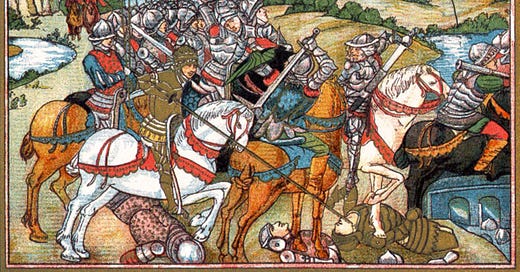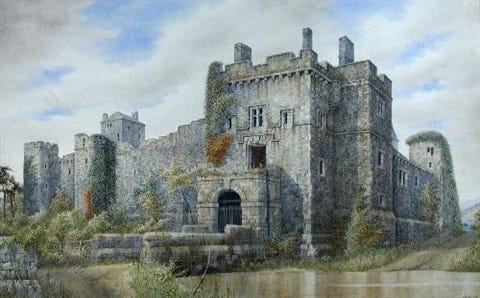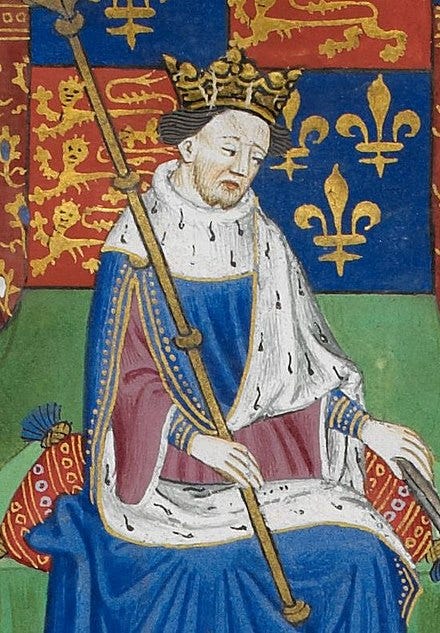Meet the aristocratic Cumbrian thug who started the Wars of the Roses
Hard-up Thomas Percy, the owner of Cockermouth Castle, felt humiliated by only being the second son of the most powerful man in the north - so he set his sights on causing trouble.
It was a bizarre sight. Two hundred undisciplined Cumberland artisans, tradesmen and tenants, swathed in black and red livery, waved tattered banners as they plodded up the steep road known as Castlegate in Cockermouth.
Riding in front of the dishevelled mob as it trooped disconsolately into Cockermouth Castle that afternoon in July 1454 was a harried-looking 32-year-old aristocrat.
Thomas Percy, the troublesome and violent second son of the powerful Henry Percy, the 2nd Earl of Northumberland, was rushing back the relative safety of his home at Cockermouth Castle.
He was returning after his reckless and ill-prepared bid to foment a Northern rebellion against the ailing King Henry VI - and his family’s hated rivals the Nevilles - had collapsed. One of the king’s loyal followers, Richard Plantagenet, third duke of York, turned up with a smaller but much more efficient band of soldiers and so Thomas scarpered.
As he cowered inside the Norman castle’s stone walls, the previously cocksure and arrogant Thomas was desperately calculating how to escape from the consequences of his treasonous act of taking up arms against the king - which could easily result in the loss of his title and lands, a crippling fine, imprisonment and, conceivably, execution.
What he did not know was that by stirring up the bitter feud between the Percies and the Nevilles, he had committed the first act in what later came to be known as the devastating Wars of the Roses.
In these wars, two rival branches of the Plantagenet dynasty - the House of Lancaster with its red rose which the Percies favoured, and the House of York with a white one whom the Nevilles were allied to - fought for control of the throne.
Tens of thousands of people would die and in the space of just 32 years the crown would change hands seven times. The struggle would eventually wipe out the male lines of the entire Plantagenet dynasty and open the way for the rise of the Tudors.
Despite being born into one of the most powerful families of 15th Century England, Thomas Percy always had a chip on his shoulder. If he were alive today, he would be the sort of rowdy young aristo who would think nothing of smashing up a restaurant and paying for the damage on his father’s credit card. You know the type. They still rule Britain today.
Part of the reason for Thomas’s volatility was the humiliation he felt at being merely a second son. His dad was the unofficial “King of the North”, Henry Percy, 2nd Earl of Northumberland, who ran the region almost as a hereditary domain. Thomas knew he was unlikely ever to inherit his father’s illustrious position.
So, like his hot-headed ancestor Harry Hotspur who rebelled against Henry IV, Thomas focused on causing trouble. One historian wrote that Thomas was “quarrelsome, violent and contemptuous of all authority. He possessed the worst characteristics of a Percy for which his grandfather Hotspur was still a byword.”
For example, in 1447 he rounded up a gang of ruffians and duffed up some tenants belonging to the Archbishop of York at Stamford Bridge and was thrown into York jail.
The king at that time was the weak, timid but well-intentioned Henry VI who was increasingly showing signs of mental instability. The monarch pleaded with Thomas’s father by letter to get Thomas under control. So Percy senior hoped that by making his son respectable he would stop embarrassing him in the family’s heartland of the North East of England.
In 1449 he gave Thomas, then 27, the “honour” of Cockermouth. At the same time the king made him Baron Egremont. This latter title brought him an income of just £10 a year - only about twice as much as a skilled craftsman would earn at the time!
The honour consisted of the two castles and the overlordship of Allerdale which included a few agricultural estates or manors such Papcastle, the Broughtons, Uldale and Aspatria bringing him total income of £100, barely £1 million a year in today’s money.
In terms of medieval aristocracy, he was not a rich man. One of the other drawbacks of this arrangement was that the honour of Cockermouth was surrounded by lands belonging to the Percies’ great rivals, the Neville family, whose powerbase was the North West.
Far from desisting, Thomas continued to foment mayhem. His brother William had landed the job as Bishop of Carlisle at the age of only 24 after some string pulling with the Pope.
Yet William neglected his flock and helped Thomas stir up what one chronicler described as “great dissections, riots and debates” among tenants belonging to Richard Neville, the 5th Earl of Salisbury. Things got so bad that “one half of the shire was divided from that other,” the historian remarked.
At one point Thomas ordered his thugs to beat up the Sheriff of Cumberland, effectively the local police chief, who was a Neville employee.
In all this Thomas’s father played a double game. While he officially instructed his sons to comply with good form, contemporary documents show the 2nd Earl privately intrigued against Salisbury as a pushy newcomer.
Claiming that his own earldom predated Salisbury’s, he accused Neville of attacking his “preemynence” in the north and argued (quite wrongly) that Salisbury’s title was only a life peerage.
Thomas had spent a large part of his youth lounging around the rougher inns and therefore had the common touch.
He used this talent to recruit artisans, tradesmen and the jobless hurt by the Great Slump. Between 1440 and 1480 the north of England suffered successive poor summers, crop failures and diseases among livestock.
An economic downturn began that spread to the rest of the country. Added to this, the aftermath of the Black Death had cut the population and so, for the first time, peasants were in a position to demand that they be paid in money wages, rather than produce.
The Percies could not afford to attract enough labour and the revenues from their northern estates plunged by a third. As the scramble among the nobility for diminishing resources intensified, the young Percy increasingly resorted to handing out his family’s distinctive red and black Percy livery to ruffians, encouraging them to take out their ire at officials who took the Neville shilling.
By July 1453 isolated skirmishes, breaking and entering and robberies perpetrated by youths from both families escalated into a near-insurrection.
The spark that pushed the ruckus to danger point was the marriage of Thomas Neville, the son of Richard, and the beautiful Maud Stanhope, niece and heiress of the immensely rich Lord Cromwell.
The marriage meant Wressle Castle, and the manor of Burwell, which had traditionally been Percy possessions, passed to the Nevilles. The landless Percy brothers were enraged by what they saw as the greedy manoeuvres of their Neville cousins.
Determined to take bloody revenge, Thomas rounded up a force of around 710 rough men including two dyers, two shoemakers six sailors and three “wandering Scots.”
He intended to assassinate the entire Neville wedding party as it passed through Heworth to the east York on 24th August 1453. Mass murder never took place, however, because the Nevilles prudently arrived with an intimidatingly large body of armed escorts.
Mutual fear of defeat, and of being disinherited by the king, ensured the confrontation dissolved into name-calling, jostling and glares. But despite the lack of fatalities, the skirmish, according to chronicler William Worcester, marked “the beginning of the greatest sorrow in England,” the Wars of the Roses.
......
This is a short extract from our book Secrets of the Crooked River, which is a kind of historical biography of the Northern Lakes and Cumbria, centred around the lovely town of Cockermouth.
You can pick up a copy, and of our latest book Secrets of the Lost Kingdom, from the New Bookshop on Main Street, Cockermouth. It is also available at the Moon and Sixpence, Lakeside, Keswick. You can get it at Bookends in Keswick and Carlisle, along with Sam Read in Grasmere.
Or you can buy it instantly here: www.fletcherchristianbooks.com







